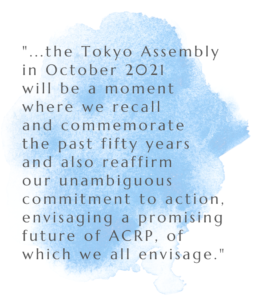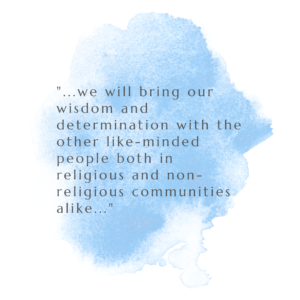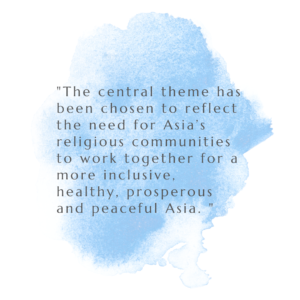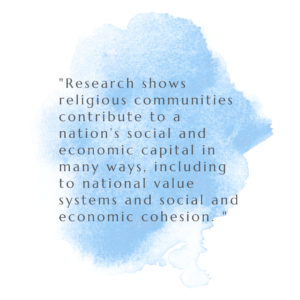1.Introduction
With its 21 member nations comprising more than half of humanity, the Asian Conference of Religions for Peace (ACRP), now generally known as Religions for Peace Asia, will hold its Ninth Asian Assembly in Tokyo in 19th-22nd October 2021 in online mode. It will be preceded by the Youth Pre-Assembly and the Women’s Pre-Assembly. Because of the unprecedented and ongoing crisis caused by the COVID-19 pandemic, the General Assembly has been delayed by a year and this year will have to be conducted virtually or online because of the uncertainties regarding travel, quarantines and vaccination roll-outs.
The General Assembly may be preceded by the delayed and simplified 2020/21 Olympic Games, and will be held via ZOOM. The central theme of the 2020/21 Asian Assembly will be Asian Religious Communities in Action: Moving towards an Inclusive, Healthy, Prosperous, Peaceful Asia in developing an interfaith movement working for positive peace and shared well-being across Asia and the Pacific based on the national chapters with the objective to create formal links with key umbrella religious organizations, governments, key international and regional agencies and relevant research organizations in universities.
Because of the pandemic, some changes have been made to the proposed architecture of the General Assembly, including a special session on the COVID-19 pandemic and Asia’s religious communities as the Plenary III of the General Assembly. Additionally, because of the Executive Committee decision in March 2021, the Assembly will be conducted online. As a result, the original set of proposals have been simplified. The Assembly will be held over 4 days and for three and a half hours per day and in the afternoon (Japan time).
The overall aims of the General Assembly are to approve a new constitution, appoint the office-bearers for the next five years, approve the Assembly declaration and, lastly, to approve a series of recommendations as part of an ACRP action plan that would guide the organization and the Tokyo secretariat until the next Assembly, probably in 2025.
2. General Assembly Aspiration
 The year 2020 has marked the 50th anniversary of the First World Assembly of Religions for Peace International (known as World Conference on Religions and Peace/WCRP then), held at Kyoto Japan in 1970. In October of the commemorative year, Asian Conference of Religions for Peace/ ACRP (also known as Religions for Peace Asia) was hoping to convene its Ninth General Assembly in Tokyo Japan, but this has been postponed for 12 months due to the pandemic of COVID-19. In this context, the Tokyo Assembly in October 2021 will be a moment where we recall and commemorate the past fifty years and also reaffirm our unambiguous commitment to action, envisaging a promising future of ACRP, of which we all envisage.
The year 2020 has marked the 50th anniversary of the First World Assembly of Religions for Peace International (known as World Conference on Religions and Peace/WCRP then), held at Kyoto Japan in 1970. In October of the commemorative year, Asian Conference of Religions for Peace/ ACRP (also known as Religions for Peace Asia) was hoping to convene its Ninth General Assembly in Tokyo Japan, but this has been postponed for 12 months due to the pandemic of COVID-19. In this context, the Tokyo Assembly in October 2021 will be a moment where we recall and commemorate the past fifty years and also reaffirm our unambiguous commitment to action, envisaging a promising future of ACRP, of which we all envisage.
In the recent past, ACRP adopted the Strategic Action Plan (2015) and the document titled, “The Remedial Strategies for ACRP’s Advancement (2017)” both of which would assist ACRP in becoming a more action-driven organization. Taking into consideration these opportunity-given documents for change, we plan to utilize the General Assembly in Tokyo to envision and make real changes in our way of thinking and in our genuine commitment on the ground to action for social communities, who need our assistance. We will be able to demonstrate that we have already changed by our already-completed achievements and success stories in the Tokyo Assembly in 2021.
We will be able to demonstrate that we have already changed by our already-completed achievements and success stories in the Tokyo Assembly in 2021.
We are urged to avoid becoming engaged in discussions, which bring about less fruitful results in our General Assembly. Rather,, who are gathered online, with the aim of making ACRP into a multi-religious movement rather than a conference. The Tokyo Assembly in 2021 therefore ought to be a showcase for reaffirming and further strengthening our commitment to concrete activities, which will assist in ameliorating the plight of people, including the most vulnerable in Asia and the Pacific.
The pandemic of COVID-19 has presented unprecedented health challenges across the world. And it has impacted negatively on the maintenance of the world economy, which sustains the well-being of the world’s population. In this context, therefore, the members of ACRP during the virtual Ninth General Assembly are tasked to plan and implement ACRP’s multi-faith commitment to concrete activities, which could become a driving force to lessen the impact of the pandemic.
3. General Assembly Objectives
The objectives of the General Assembly are:
1) To streamline ACRP and make it a more action-oriented organization;
2) To reaffirm and strengthen ACRP’s commitment and engagement in assisting people, whose lives and livelihood are being placed at risk in the Asia-Pacific region, in collaboration with other partners so that we can provide genuine benefits for them;
3) To advance ACRP further in a changing Asia-Pacific region;
4. Modality of Assembly Presentation
The Ninth General Assembly of ACRP will be convened online. The virtual Assembly will be proceeded with the software called “ZOOM Meeting” not “ZOOM Webinar” so that the open communication cannel among the Assembly participants can be secured.
The Plenary Session I, IV and V on business will be the closed session, and the Opening & Closing Ceremonies, Plenary Sessions II & III and Commission Session will be open to the wider audience. The YouTube channel will be available for the open programs.
At present, it is conceived that a stage as the hub of the four-day operation of the General Assembly is to be set up as long as the Assembly Budget permits and it is technically feasible. Those, who wish to join the open sessions of the Tokyo Assembly, are required to register with them in advance.
5. General Assembly Main Theme and Sub-themes
1) The main theme of the Tokyo Assembly
The main theme of the Tokyo Assembly is Asian Religious Communities in Action: Moving towards an Inclusive, Healthy, Prosperous, Peaceful Asia.
2) The sub-themes of the Tokyo Assembly
The sub-themes of the Tokyo Assembly are:
i) Education for Peace and Human Dignity: Challenges for an Inclusive, Healthy, Prosperous, Peaceful Asia
ii) Human Rights and Well-being for the Vulnerable: Challenges for an Inclusive, Healthy, Prosperous, Peaceful Asia
iii) Reconciliation for Social Cohesion and Harmony: Challenges for an Inclusive, Healthy, Prosperous, Peaceful Asia
iv) Development and the Environment in Diversifying Societies: Challenges for an Inclusive, Healthy, Prosperous, Peaceful Asia
6. Background of the Theme Setting
 The central theme has been chosen to reflect the need for Asia’s religious communities to work together for a more inclusive, healthy, prosperous and peaceful Asia. Asia with the adjacent area of the Middle East is the birthplace of all the world’s major religions and their various traditions. The Asian Conference of Religions for Peace was formally founded in 1976 soon after the foundation in 1970 of Religions for Peace International, known also as the World Conference of Religions for Peace (WCRP), in which year it held its first World Assembly at Kyoto. Hence, the Tokyo Assembly will mark 50 years, though it was delayed a year, since the foundation of WCRP and the Kyoto Assembly.
The central theme has been chosen to reflect the need for Asia’s religious communities to work together for a more inclusive, healthy, prosperous and peaceful Asia. Asia with the adjacent area of the Middle East is the birthplace of all the world’s major religions and their various traditions. The Asian Conference of Religions for Peace was formally founded in 1976 soon after the foundation in 1970 of Religions for Peace International, known also as the World Conference of Religions for Peace (WCRP), in which year it held its first World Assembly at Kyoto. Hence, the Tokyo Assembly will mark 50 years, though it was delayed a year, since the foundation of WCRP and the Kyoto Assembly.
The foundation of WCRP was mostly inspired by the atomic bomb attacks in 1945 and the need for religious communities to work collaboratively in the cause of global and regional peace and national cohesion. After the painful memories of World War II in the face of the threat that a new war would end in nuclear annihilation, in the words of Dr William Vendley, the Secretary-General Emeritus of Religions for Peace International, “Independently of each other, religious communities and some of their leaders began focusing on the idea that global challenges demanded a global alliance of the different religions”.
Trees are seen by most religions as symbolizing hope, and the revered survivor trees of Hiroshima point to the hope that peace can be achieved by the religious communities working together. The Asian landscape is dotted with temples, mosques, churches and gurdwaras such as the holy city of Varanasi in India, the Shwedagon pagoda in Yangon, the Mt. Putuo island monastery in China, the MacKillop holy shrine in Sydney and the Puchong Perdana mosque in Malaysia, reflecting the many Asian spiritualities and the spiritual genius of the peoples of Asia.
1) Asia as Inclusive
The General Assembly wants to encourage and promote Asia’s many and very diverse religious communities to move towards an Asia that is inclusive, where there is no social or religious exclusion or alienation, which is free of social vulnerability, social and sexual stigma, caste exclusiveness, sexual and gender discrimination, hate speech and fake news, where there is freedom of religion and belief in worship and practice, in education and in social policy and where bad religion or bad religious practices are resisted and expunged.
Asian inclusivity will take place mainly in cities. Especially pertinent to Asia has been the global growth of cities. The last decade has seen a very historic tipping point – for the first time in human history, more people are living in cities than in rural areas. By 2050, 70 per cent of all people on this earth will live in urban areas. Asia is presently home to half of the world’s urban population, and to 66 of its 100 fastest growing urban areas, of which 33 are in China alone. While most growth will occur in cities and towns, there is also the fact of the megacities (10+ million people) – there are currently 21 with 10 in Asia: Tokyo (36.5M), Delhi (21.7M), Mumbai (19.7M), Shanghai (16.3M), Kolkata (15.3M), Dhaka (14.3M), Karachi (12.8M), Beijing (12.2M), Manila (11.4M) and Osaka-Kobe (11.3M).
According to UNICEF’s 2012 Report of the State of the World Children which focused on Children in an Urban World, more than a billion children live in urban areas, many enjoying the advantages of urban life. But there are too many who are living in marginalized urban slums, vulnerable to violence and exploitation as well as to injuries, illness and death. Too many children are denied such essentials as clean water, electricity and appropriate health care. The key question is: how do we make our cities more livable and more sustainable? How can we harness the new knowledges and the new technologies to make the cities cleaner, richer and less dangerous, more connected and more cohesive? Religious communities are now centered more in cities than in villages yet how do they work to improve urban living?
2) Asia as Healthy
The COVID-19 pandemic has impacted globally, not least in the Asia-Pacific region. As with the 1918-1920 Spanish flu epidemic where there is no agreement a century later of where and how it started, it is likely that there will be no agreement as to how and where this 21st century pandemic originated. A WHO taskforce is examining the issue. As has been shown in history over 4,000 years, faith and interfaith leaders and their communities have a special role to play in coping with the actual health crisis and in dealing with the social and economic consequences.
TABLE ONE:COVID-19 PROFILE: ACRP AND SELECTED COUNTRIES (as of August 31, 2021)


Source: John Hopkins University Coronavirus Resource Center, Baltimore; data not available on other ACRP countries. Prepared by Professor Des Cahill, Australia
The figures (see Table One) suggest that the Asian countries have been less impacted than the European and American nations, probably because they had had previous experience in dealing with the SARS virus. Almost every country has had to take unpopular measures such as lockdowns, curfews and physical and social distancing. Religious communities have been directly impacted with the deaths of religious leaders, the need for protection of religious health workers, the crisis in funeral services, the decline in financial income and the pressure on their welfare services in feeding hungry people, helping them to be properly housed and dealing with the spiritual and psychological consequences. Religious communities can be immensely valuable to society in a pandemic, and with their grassroots connectedness they are strategically placed to strongly influence the success of COVID-19 responses in their community connections, their work with vulnerable groups and their provision of community services. But often the possibility for this can be hampered because there is a lack of coordination with government authorities. The postponement of the 2020 Asian Assembly provides a unique opportunity to reflect on the responses of religious communities and their governments to this unprecedented global crisis.
Religious communities can be immensely valuable to society in a pandemic, and with their grassroots connectedness they are strategically placed to strongly influence the success of COVID-19 responses in their community connections, their work with vulnerable groups and their provision of community services. But often the possibility for this can be hampered because there is a lack of coordination with government authorities. The postponement of the 2020 Asian Assembly provides a unique opportunity to reflect on the responses of religious communities and their governments to this unprecedented global crisis.
3) Asia as Prosperous
The Asian Assembly wants to include a prosperous Asia as one of its key objectives. Research shows religious communities contribute to a nation’s social and economic capital in many ways, including to national value systems and social and economic cohesion. In recent decades, the Asia-Pacific region has been an economic success story. The Asian Development Bank has continued to argue for inclusive growth through creating opportunities (investing in growth) and broadening access (investing in people). Religions can assist governments in developing an enabling environment for public and business investment and private entrepreneurship through investing in infrastructure and human capital, building institutional capacity, adopting just and market-friendly policies and maintaining rigorously the rule of law. There has been a strong reduction in multidimensional poverty, led by China and Indonesia, over the past two decades.
But Asia’s impressive growth has masked that the region’s population still remains poor and vulnerable with rapidly rising relative and absolute inequalities. Through the UN’s Global Multidimensional Poverty Index, the UNDP, based on 2014-2019 surveys of developing countries, has estimated the percentage of the population living below the national income poverty line. For the ACRP developing countries, the percentages were Bangladesh (24.3%), Cambodia (17.7%), China (1.7%), India (21.9%), Indonesia (9.8%), Myanmar (24.8%), Nepal (25.2%), Pakistan (24.3%), the Philippines (21.6%), Sri Lanka (4.1%), Thailand (9.9%) and Timor-Leste (41.9%).
However, the COVID-19 pandemic is putting these Asian gains at risk as the health and economic sectors are being severely affected. In its September 2020 Dialogue, UNDP explained how the progress is being jeopardized in reducing poverty, highlighting in particular, through their simulations, reductions in nutritional levels and children’s school attendance. It estimates that the increases in deprivations of lives and livelihoods may set poverty levels back by 9.1 per cent. Unlike richer people, the poor cannot simply shrug aside the economic shock. The poor will also have less access to vaccination, especially in rural areas. In 2020 Asia and the Pacific could suffer $1.7 – 2.5 trillion in losses and this accounts for about 30 per cent of the overall decline in global output.
There is much that is uncertain and ambiguous about Asia’s prosperity and about any gradual re-opening and introduction and the calibrating of health and economic policies and programs. Pope Francis has argued, “It is time to decide to live differently, to live better, to love more and to care more”, calling for debt reduction, even debt forgiveness, and adding that “we must cure a greater virus, that of social injustice, inequality of opportunity, marginalization and the lack of the protection of the weakest”.
4) Asia as Peaceful
The ACRP General Assembly wants its religious communities to move towards a more peaceful Asia. While most of the Asia-Pacific region lives in peace, the spectre of the Korean Peninsula situation hangs heavily over the world as does the continuing Afghanistan struggle. Asia is being impacted by the Syrian Civil War, the Yemeni conflict, the contested situation with Iran and, in 2021, by the military coup in Myanmar. In the last years, UNDP has drawn attention to the deaths from the conflicts in Kashmir, Balochistan and the Khyber Pakhuntkhwa in Pakistan, Myanmar (Kachin, Karen, Rohingya), the Naxolite insurgency in India, and the conflicts in southern Thailand and the southern Philippines.
The 2020 Global Peace Index prepared by the Institute for Economics and Peace for its 163 countries which uses a vast range of indices lists the following Asian countries at the bottom of the scale from 100 – 163: Papua New Guinea (rank 101, score 2.157), Uzbekistan (103, 2.158), China (104, 2.166), Tajikistan (107, 2.188), Thailand (114, 2.245), Turkmenistan (116, 2.276), , Myanmar (127, 2.424), Philippines (129, 2.471), India (139, 2.628), North Korea (151, 2.962), Pakistan (152, 2.973) and, as last, Afghanistan (163, 3.644). The Asian countries that ranked in the top twenty for peacefulness were: New Zealand (2, 1.198), Singapore (7, 1.321), Japan (9, 1.360), Australia (13, 1.386), Bhutan (19, 1.501) and Malaysia (20, 1.525c). Overall, the level of global peacefulness has been declining over the past decade.
Regarding terrorist attacks in 2018 by non-state actors where there were more than ten deaths, the Uppsala Conflict Data Program of Uppsala University in Sweden lists those in Afghanistan (Baghlin, Gardez, Herat, Jalalabad, Kabul, Kama, Khost, Khwaja Umari, Lashkargah, Muse, Rodat and Urozgan), in Pakistan (Datta Teksil, Kabal Teksil, Mastung, Peshawar, Quetta, Raiwind and Wanna), in Indonesia (Surabaya and Sidoarjoi), in India (Sukma) and Myanmar (Mohnyin). In the first half of 2019, the Uppsala listing names terrorist attacks in Afghanistan (Bala Murghab, Gulistan, Helmand, Maidan Shar, Murghab, Qaysar, Sangin, Sar-e Pol, Shahrah, Shorobak and Spin Boldak), in Sri Lanka (Colombo, Negombo and Batticolea), in Pakistan (Lahore, Quetta), the Philippines (Jolo), India (Gadchiroli and Pulwama) and at Christchurch in New Zealand by an Australian gunman.
New threats to Asia’s peace have emerged with an emerging serious trade war fueled by populist-inspired nationalisms and ethnocentrisms, the dangers contained in cyber realities as Asia moves to a 5G tech world with cyber attacks, cyber pornography etc. and the dangers of social media, hateful speech and fake news.
5) The Impact of Religious Communities
Hence, the main theme of the Ninth General Assembly in October 2021 is directed towards mobilizing religious communities, diverse and different as they are across Asia, to action and more action to make Asia more at peace and more inclusive and to be physically and spiritually healthy. According to the Pew Research Center, 84 per cent of the world’s people have a religious commitment. Hence, at both the grassroots and the national levels, religious leaders and their communities can have a powerful impact, not least in achieving the UN’s five Ps of sustainable development, namely People, Planet, Prosperity, Peace and Partnership, and the 17 goals of the 2030 Sustainable Development Agenda. ACRP wishes not only to be a partnership of member nations but also a movement for building peace and inclusiveness as well as providing for the spiritual, psychological and physical health needs through activating the religious values of love, care, hope and connectedness.
6. ACRP and its Objectives
The objectives of the Asian Conference of Religions for Peace (ACRP) to be approved at the Ninth General Assembly are:
(a) to work with faith traditions and religious organizations for interreligious understanding and harmony in the Asian-Pacific region and across the world, including the right to freedom of religion and belief and in the pursuit of peace, justice and human dignity
(b) to promote the salience of spirituality and religion in the multireligious Asia-Pacific region, highlighting its resources and the importance of religion and spirituality and combatting the false and negative aspects of religion
(c) to work with other religious and interreligious organizations in bringing about peace, interfaith understanding, interreligious harmony and religious freedom
(d) to work with intergovernmental, governmental and civil agencies in achieving global, regional and local peace and harmony as well as social stability and cohesion
(e) to work positively and cooperatively with Religions for Peace International and other regional and specialist organizations
(f) to create social wealth for the countries of the Asia-Pacific, ensuring that the role of religious bodies is positively appreciated
(g) to sponsor activities, events and special initiatives into the multicultural and multi-religious aspects of the region and individual nations
(h) to work with educational bodies to educate the different levels and sectors of the region and its individual countries about religion itself and the many faith traditions
(i) to organize meetings for dialogue between religious leaders at global, regional and national levels and with political and civic leaders
(j) to encourage and implement interreligious activity and projects and the formation of interreligious organizations among particular groups
(k) to work through its networks for the well-being of vulnerable groups, including women and young people, and the well-being of the environment
ACRP believes in the intrinsic value of religion at its best with its various spiritualities. Its positive functions are:
(1) religious communities add to the social, moral and economic wealth of a community and nation
(2) religious communities inspire by their individual spiritualities to promote and sustain human dignity
(3) religion offers spiritual comfort and healing as well as moral wisdom
(4) religious communities are a practical source of volunteers
(5) religion has the surge capacity to respond to immediate needs
(6) religion has unique connections between the micro- and macro-levels of society
(7) religious communities have important diversity resources for interfaith and intercultural expertise and
(8) each religious community brings unique experiences, all of which ‘make the desert blossom as a rose’.
Following the Tenth World Assembly held in Lindau in southern Germany in August 2019, the Ninth ACRP Assembly through its four Commissions wishes to advance the cause of a multi-religious vision of positive peace and shared human well-being through preventing and transforming violent conflicts, promoting just and harmonious societies, advancing integral human development and protecting the earth as well as learning from and recovering from the COVID-19 pandemic.
